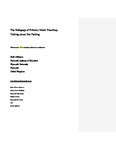The pedagogy of primary music teaching: talking about not talking
| dc.contributor.author | Atkinson, Ruth | |
| dc.date.accessioned | 2017-06-05T13:54:50Z | |
| dc.date.available | 2017-06-05T13:54:50Z | |
| dc.date.issued | 2017-05-16 | |
| dc.identifier.issn | 1461-3808 | |
| dc.identifier.issn | 1469-9893 | |
| dc.identifier.uri | http://hdl.handle.net/10026.1/9426 | |
| dc.description | peerreview_statement: The publishing and review policy for this title is described in its Aims & Scope. aims_and_scope_url: http://www.tandfonline.com/action/journalInformation?show=aimsScope&journalCode=cmue20 | |
| dc.description.abstract |
In English primary schools, provision of musical music lessons is often lacking. This paper focuses on whether a lack of clarity around primary music pedagogy might be a contributing factor. Some comparisons are drawn with the realm of second-language teaching. A small qualitative study is reported in which three teacher-educators with responsibility for primary music, from different higher education institutions, were interviewed to explore their pedagogic perspectives and articulacy. There was little evidence of shared pedagogy and interviewees often struggled to explain effective practice. However, one common theme was the implication that to teach musically a teacher needs to ‘feel like a musician’ at some level. It is suggested that teacher-educators might benefit from more clearly articulating ‘pedagogic content knowledge’ (Shulman, Lee. 1987. “Knowledge and Teaching: Foundations of the New Reform.” Harvard Educational Review 57 (1): 1–23) for primary music, including the dimension of ‘feeling like a musician’. This could, in turn, enhance work with student teachers and perhaps enable more teachers to teach musically. | |
| dc.format.extent | 1-10 | |
| dc.language | en | |
| dc.language.iso | en | |
| dc.publisher | Informa UK Limited | |
| dc.subject | Musical pedagogy primary-school music teaching | |
| dc.title | The pedagogy of primary music teaching: talking about not talking | |
| dc.type | journal-article | |
| dc.type | Journal Article | |
| plymouth.author-url | https://www.webofscience.com/api/gateway?GWVersion=2&SrcApp=PARTNER_APP&SrcAuth=LinksAMR&KeyUT=WOS:000432213900001&DestLinkType=FullRecord&DestApp=ALL_WOS&UsrCustomerID=11bb513d99f797142bcfeffcc58ea008 | |
| plymouth.issue | 3 | |
| plymouth.volume | 20 | |
| plymouth.publication-status | Published | |
| plymouth.journal | Music Education Research | |
| dc.identifier.doi | 10.1080/14613808.2017.1327946 | |
| plymouth.organisational-group | /Plymouth | |
| plymouth.organisational-group | /Plymouth/Faculty of Arts, Humanities and Business | |
| plymouth.organisational-group | /Plymouth/Faculty of Arts, Humanities and Business/Plymouth Institute of Education | |
| plymouth.organisational-group | /Plymouth/Users by role | |
| plymouth.organisational-group | /Plymouth/Users by role/Academics | |
| dcterms.dateAccepted | 2017-04-09 | |
| dc.identifier.eissn | 1469-9893 | |
| dc.rights.embargoperiod | Not known | |
| rioxxterms.versionofrecord | 10.1080/14613808.2017.1327946 | |
| rioxxterms.licenseref.uri | http://www.rioxx.net/licenses/all-rights-reserved | |
| rioxxterms.licenseref.startdate | 2017-05-16 | |
| rioxxterms.type | Journal Article/Review |


